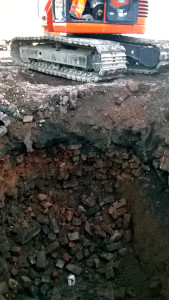Uncharted mineworkings cause headache for transport bosses.
The laying of new Metro tram tracks over former mineworkings in Wolverhampton city centre has resumed after engineers devised a way of tackling the unstable and potentially dangerous site.
They were uncovered on the A41 Bilston Road between the junctions with Steelhouse Lane and Hospital Street in November as work progressed on replacing worn out tram tracks. And after intensive efforts to find a safe way of building over the mine, work is now underway with tram services scheduled to resume running into the St George’s terminus in March.
The old workings, which are up to 12 metres (40ft) deep, 55 metres (180ft) long and 20 metres (65ft) wide, are thought to date as far back as the Industrial Revolution, when coal and iron ore was mined extensively across the Black Country.
Centro, the region’s public transport co-ordinator which is behind the £4.5 million track improvement scheme, consulted with specialist engineering consultants to assess how best to deal with them. It also sought advice from other light rail systems in the UK and around the world to see if they had ever dealt with a similar problem and to identify the best solution.
Engineers have now devised a solution consisting of a geo-textile membrane and geogrid to stabilise the ground, in between layers of compacted hardcore and capped with a reinforced 5 metre wide concrete slab running through the 55 metre length of the workings.
Midland Metro programme director Paul Griffiths said at some point down the years the workings had been filled in with old building rubble then covered over without being marked on any known map or documents. “The problem was that rubble was not compacted down, it was thrown in loose and covered over, and over time loose rubble shifts and creates voids,” he said.
“Having installed a modern new crossover south of The Royal we came to remove the foundation from the previous crossover and that’s when we found the mine workings. We had undertaken ground investigation in advance of the works including using ground penetrating radar, but this did not identify all the issues. It was only when we were able to open up the ground and make a full analysis that the sheer scale of the problem became clear.”
The timetable had already been hit by the discovery of unmarked public utility pipes and the discovery that the original track slab was not as strong as designed and required additional work to ensure it does not deteriorate in the future. Originally planned to open in November, The Royal opened the following month.
However, an announcement on when services would resume to St George’s could not be made until the evaluation of the workings and design of a solution was completed. That happened this week following intensive ground investigation and design work over Christmas and New Year.
Mr Griffiths said: “The design of the solution has been complicated by the location between the two carriageways of Bilston Road. This has prevented the material from simply being dug out as it could have damaged the integrity of the road.”
While this took place, rebuilding work of the new St George’s terminus was accelerated and new track laid heading out to The Royal. Cllr Roger Horton, Centro lead member for rail, said: “The delays have been incredibly frustrating and we recognise the impact they have had on users of the Midland Metro for which we apologise.
“However these works have had to be done. An operational tram system has to have secure foundations, and now that this is being done the Midland Metro will provide Wolverhampton with a system it can be proud of for years to come.”



